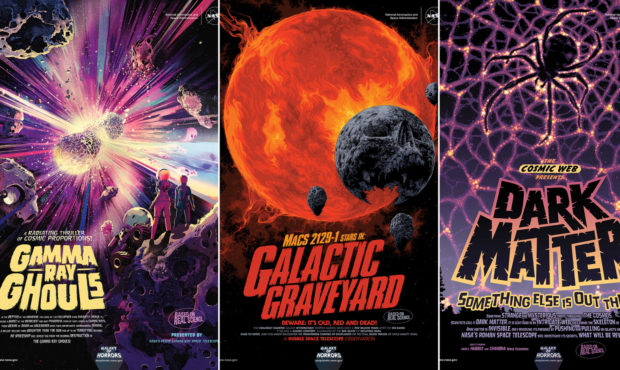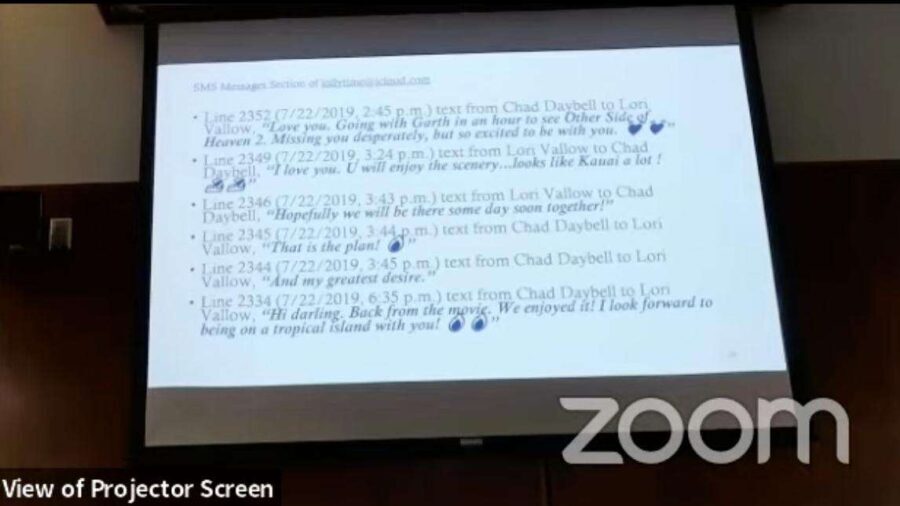New NASA posters share galactic horrors for Halloween
Oct 30, 2020, 6:33 AM | Updated: 6:48 am

With Halloween just around the corner, NASA has released its latest Galaxy of Horrors posters. Presented in the style of vintage horror movie advertisements, the new posters feature a dead galaxy, an explosive gamma ray burst caused by colliding stellar corpses, and ever-elusive dark matter. Credit: NASA/JPL-Caltech
(CNN) — Although our universe is full of wonders, it’s equally riddled with horrors.
Colorful posters styled like vintage horror movie adverts highlight some of these cosmic frights in the latest release from NASA’s Exoplanet Exploration Office at the Jet Propulsion Laboratory in Pasadena, California.
The posters are free to download from NASA’s site, and they’re also available in Spanish.
Released just in time for Halloween, the posters shed light on dangers and mysteries across the universe. The agency has also released a SoundCloud playlist that includes the scary sounds of space.
Previous posters have highlighted the wonders of our own solar system as well as potentially habitable exoplanets, or planets outside of our solar system, where they imagine how humans might one day visit these faraway places.
But the phenomena illustrated in these posters are a little more sinister.
The posters combine imaginative artistic renderings with intriguing science. Teams of artists and scientists have been collaborating on them since 2014.
Across the universe: NASA hopes at-home activities will inspire future astronomers
The latest additions to NASA’s Galaxy of Horrors poster collection include elusive dark matter, a deadly gamma ray burst and a “galactic graveyard.”
The galactic graveyard poster showcases an old galaxy where star birth suddenly halted just a few billion years after the big bang. Now, it’s a graveyard of decaying stars and the only stars that remain are small and red, which cast an eerie red glow.
“Dare to enter, and you might encounter the frightening corpses of exoplanets or the final death throes of once-mighty stars,” reads the JPL caption.
The “Gamma Ray Ghouls” poster shows what happens when dead stars collide: a gamma ray burst. This is one of the most powerful explosions in the universe.
“These beams of doom are unleashed upon their unfortunate surroundings, shining a million trillion times brighter than the Sun for up to 30 terrifying seconds. No spaceship will shield you from the blinding destruction of the gamma ray ghouls!” says the text on this poster.
And then there is dark matter. This invisible gravity provides structure for the universe, but scientists don’t know what it’s made of and have tried to detect a dark matter “particle” for years.
“One of the things I really like about these posters is that if you spend some time studying the art and then maybe go learn a little more about each of these topics, you’ll see there was a lot of thought by the artists about the choices they made to highlight the science,” said Jason Rhodes, an astrophysicist at JPL who consulted on the project, in a statement.
For example, the spiderweb used in the dark matter poster is a clever allusion to the cosmic web structure of the universe, which connects galaxies together, that we can’t see.
The gamma ray poster also highlights the danger of being caught close to the collision between dead stars and the energy they would unleash.
Judy Racusin, an astrophysicist at NASA’s Goddard Space Flight Center who also consulted on the posters, highlighted how rare gamma ray bursts are — so they aren’t likely to impact Earth.
A gamma ray burst goes off in our galaxy only about once every 10,000 years, but they are visible to us only about every 10 million to 100 million years, according to NASA.
“The poster art is a really fun way to imagine one of these happening,” Racusin said. “But I wouldn’t want to be those space travelers!”
The-CNN-Wire
™ & © 2020 Cable News Network, Inc., a WarnerMedia Company. All rights reserved.













